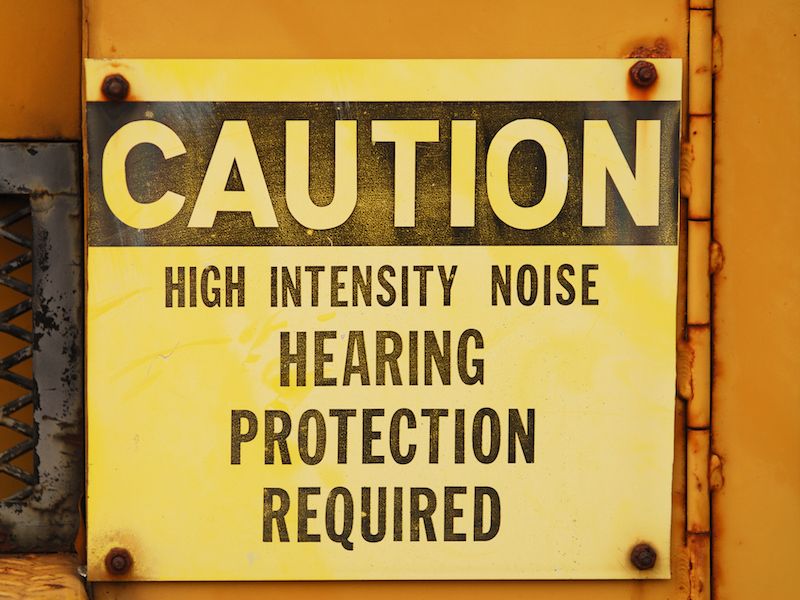
It’s one thing to know that you need to protect your ears. It’s another matter to know when to protect your ears. It’s not as straight forward as, for example, determining when to use sunscreen. (Are you going outside? Is there sunlight? You should be using sunblock.) Even knowing when you need eye protection is easier (Doing some hammering? Cutting some wood or working with dangerous chemicals? Wear eye protection).
It can feel like there’s a large grey area when addressing when to use ear protection, and that can be dangerous. Usually, we’ll defer to our natural inclination to avoid hearing protection unless we’re given information that a particular activity or place is dangerous.
Risk Evaluations
In general, we’re not very good at assessing risk, especially when it comes to something as intangible as lasting hearing problems or hearing loss. To demonstrate the situation, here are some examples:
- Person A attends a very loud rock concert. The concert lasts roughly 3 hours.
- Person B runs a landscaping business. She spends a considerable amount of time mowing lawns, then goes home to a quiet house and reads.
- Person C is an office worker.
You might presume that person A (let’s call her Ann, to be a little less clinical) might be in more hearing danger. For most of the next day, her ears will still be ringing from the loud concert. It seems rational to presume that Ann’s recreation was very risky.
Person B (let’s just call her Betty), on the other hand, is exposed to less noise. Her ears don’t ring. So her ears must be less hazardous, right? Well, not really. Because Betty is mowing all day. So although her ears don’t ring out with pain, the injury accrues bit by bit. If experienced too often, even moderately loud sounds can have a harmful affect on your ears.
What’s happening with person C (let’s call her Chris) is even more difficult to make sense of. The majority of people recognize that you should protect your ears while running machines like a lawnmower. But while Chris works in a quiet office, she has a really noisy, hour-long commute every day on the train. In addition, she sits at her desk and listens to music through earbuds. Does she need to think about protection?
When is it Time to Start to Consider About Protecting Your Ears?
Generally speaking, you should turn down the volume if you have to shout to be heard. And you should consider wearing earplugs or earmuffs if your environment is that noisy.
So to put this a little more scientifically, you should use 85dB as your cutoff. Sounds above 85dB have the capacity to cause damage over time, so you should give consideration to wearing hearing protection in those scenarios.
Your ears don’t have their own sound level meter to alert you when you reach that 85dB level, so many hearing specialists recommend getting special apps for your phone. You will be capable of taking the appropriate steps to safeguard your hearing because these apps will inform you when the noise is reaching a dangerous volume.
A Few Examples
Your phone might not be with you wherever you go even if you do get the app. So a few examples of when to safeguard your ears might help you develop a good baseline. Here we go:
- Residential Chores: We already talked about how something as basic as mowing the lawn, when done frequently, can call for hearing protection. Cutting the grass is a great example of the type of household job that could cause injury to your hearing but that you probably don’t think about all that often.
- Commuting and Driving: Do you drive for Lyft or Uber? Or maybe you’re just hanging around downtown for work or boarding the subway. The constant noise of city living, when experienced for between 6 and 8 hours every day, can cause damage to your hearing over the long term, especially if you’re turning up your music to hear it over the commotion.
- Using Power Tools: You understand you will require hearing protection if you work all day in a factory. But how about the enthusiast building in his workshop? Most hearing specialists will suggest you wear hearing protection when operating power tools, even if it’s just on a hobbyist level.
- Exercise: You know your morning spin class? Or even your evening Pilates session? You may consider using hearing protection to each one. The high volume from trainers who use loud music and microphones for motivation, though it might be good for your heart rate, can be bad for your hearing.
- Listening to music with earbuds. This one calls for caution, not protection. Whether your music is playing directly into your ears, how loud it is playing, and how long you’re listening to it are all things you need to give consideration to. Think about getting headphones that cancel out outside noise so you don’t have to crank up the sound to damaging levels.
A strong baseline may be established by these examples. When in doubt, though, you should defer to protection. Instead of leaving your ears exposed to future injury, in most circumstances, it’s better to protect your hearing. Protect today, hear tomorrow.
